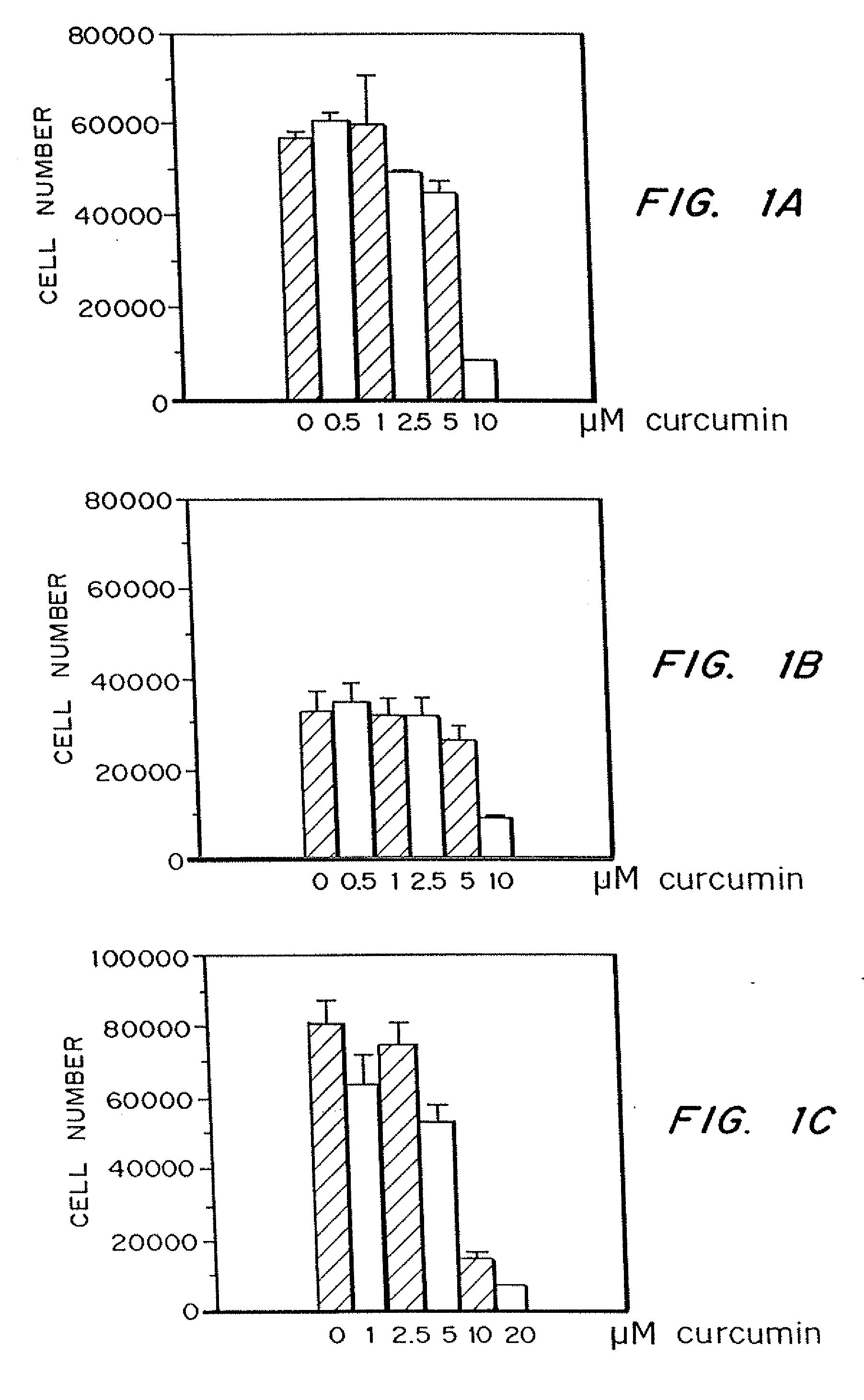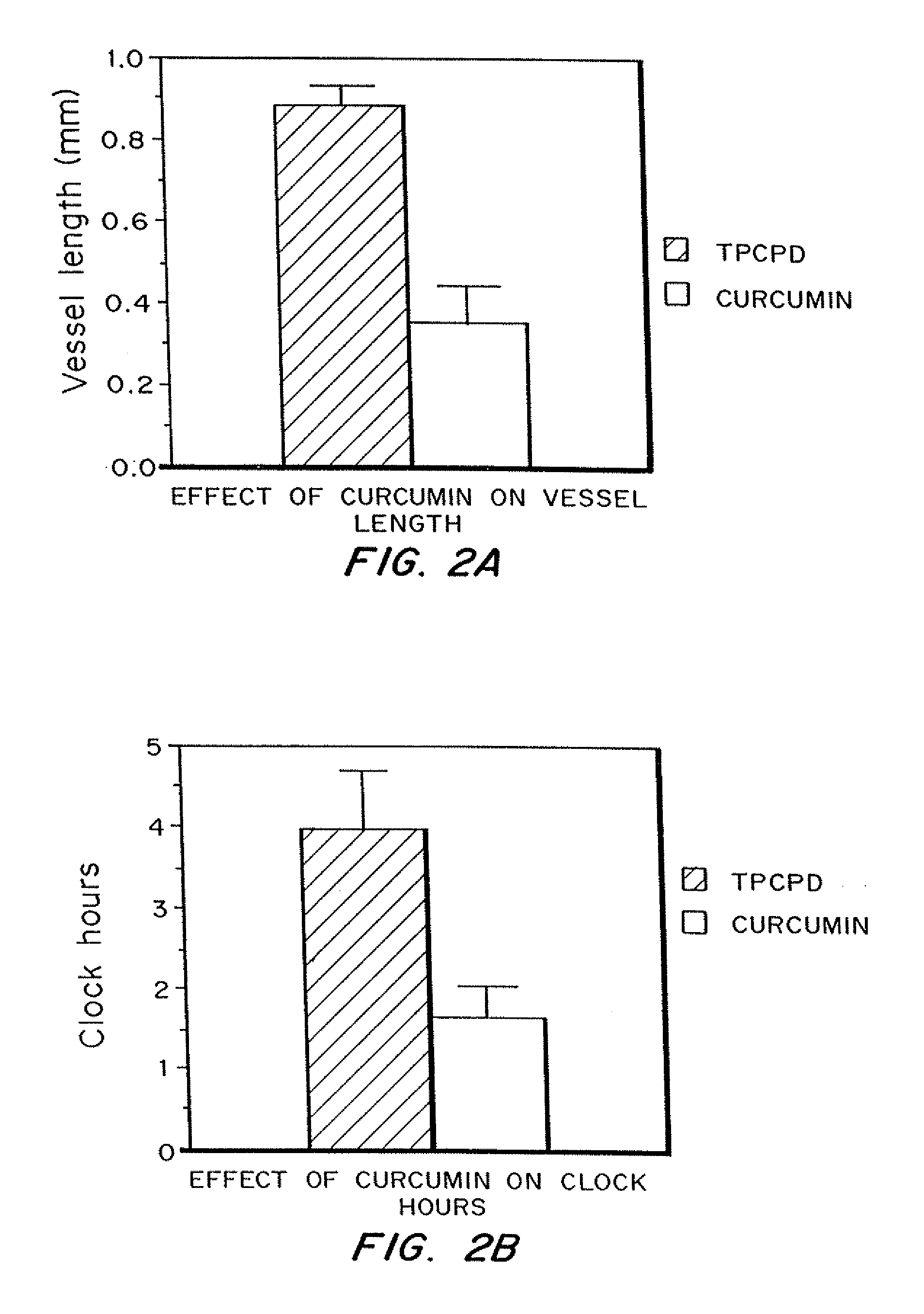Curcumin and curcuminoid inhibition of angiogenesis
a curcumin and curcumin technology, applied in the field of inhibition of angiogenesis, can solve the problems of limited effectiveness of current treatments for cancer and related diseases, numerous serious unintended effects, and interventions that may have serious unanticipated effects, and achieve the effects of inhibiting angiogenesis, reducing the risk of recurrence, and increasing the level of bfg
- Summary
- Abstract
- Description
- Claims
- Application Information
AI Technical Summary
Benefits of technology
Problems solved by technology
Method used
Image
Examples
example 1
Curcumin Inhibition of Endothelial Cell Proliferation is Dependent on Curcumin Dose and the Presence or Absence of Basic Fibroblast Growth
[0076]Endothelial cells were stimulated to proliferate in the presence of 1 ng / ml bFGF. Curcumin was added in concentrations ranging from 0.5 to 10 μM to primary endothelial cells.
[0077]FIGS. 1A-C describe the effect of curcumin on endothelial cell proliferation in the absence of basic fibroblast growth factor (FGF; FIG. 1A), in the presence of bFGF (FIG. 1B) and in the absence of bFGF, where the endothelial cells have been transformed (FIG. 1C). A steep decrease in cell number was seen at 10 μM. No evidence of cytotoxicity was observed, and the number of cells at the end of treatment was not significantly less than the number cells originally plated. This decrease in proliferation due to curcumin concentration of 10 μM was observed in both the presence or absence of bFGF.
[0078]In addition, curcumin was able to inhibit the growth of endothelial ce...
example 2
Curcumin Inhibition of Corneal Neovascularization is Dependent on the Presence of Basic Fibroblast Growth Factor
[0079]The ability of curcumin to inhibit bFGF-induced corneal neovascularization in vivo was measured. Pellets were prepared containing 80 ng of bFGF and curcumin, or a control aromatic ketone, tetraphenylcyclopentadienone (TPCPD). TPCPD was added to rule out the possibility that the inhibition of neovascularization due to curcumin was not secondary to dilution. Neovascularization was assessed by slit lamp at 5 days after implantation, and the corneas were photographed.
[0080]FIGS. 2A-2B describe the effect of curcumin on the extent of bFGF-stimulated neovascularization in the mouse cornea (FIG. 2A), in relation to bFGF-stimulated neovascularization in the absence of curcumin (FIG. 2B). There was no difference in neovascularization in mice containing bFGF pellets in the presence or absence of TPCPD. Both the vessel length and sectpr sizes were significantly reduced in the p...
example 3
Curcumin and Other Curcumin Analog Inhibition of Corneal Neovascularization in the Presence of Basic Fibroblast Growth Factor is Dependent on the Dose and Structure of the Curcuminoid
[0081]Three curcumin analogs were assayed for their ability to inhibit bFGF-induced corneal neovascularization as described above.
[0082]FIGS. 3A and 3B describe the effect of curcumin and other curcuminoids, tetrahydrocurcumin, bisdemethoxycurcumin, and demethoxycurcumin, on corneal neovascularization, as measured by vessel length (FIG. 3A) and by sector size (FIG. 3B). All analogs showed inhibitory activity, with demethoxycurcumin showing the greatest activity on both sector size and vessel length, tetrahydrocurcumin having the least effect on sector size, and bisdemethoxycurcumin having the least effect on vessel length. All of the curcumin analogs showed significant inhibition of bFGF-mediated neovascularization compared with control pellets.
PUM
| Property | Measurement | Unit |
|---|---|---|
| Length | aaaaa | aaaaa |
| Length | aaaaa | aaaaa |
| Length | aaaaa | aaaaa |
Abstract
Description
Claims
Application Information
 Login to View More
Login to View More - R&D
- Intellectual Property
- Life Sciences
- Materials
- Tech Scout
- Unparalleled Data Quality
- Higher Quality Content
- 60% Fewer Hallucinations
Browse by: Latest US Patents, China's latest patents, Technical Efficacy Thesaurus, Application Domain, Technology Topic, Popular Technical Reports.
© 2025 PatSnap. All rights reserved.Legal|Privacy policy|Modern Slavery Act Transparency Statement|Sitemap|About US| Contact US: help@patsnap.com



